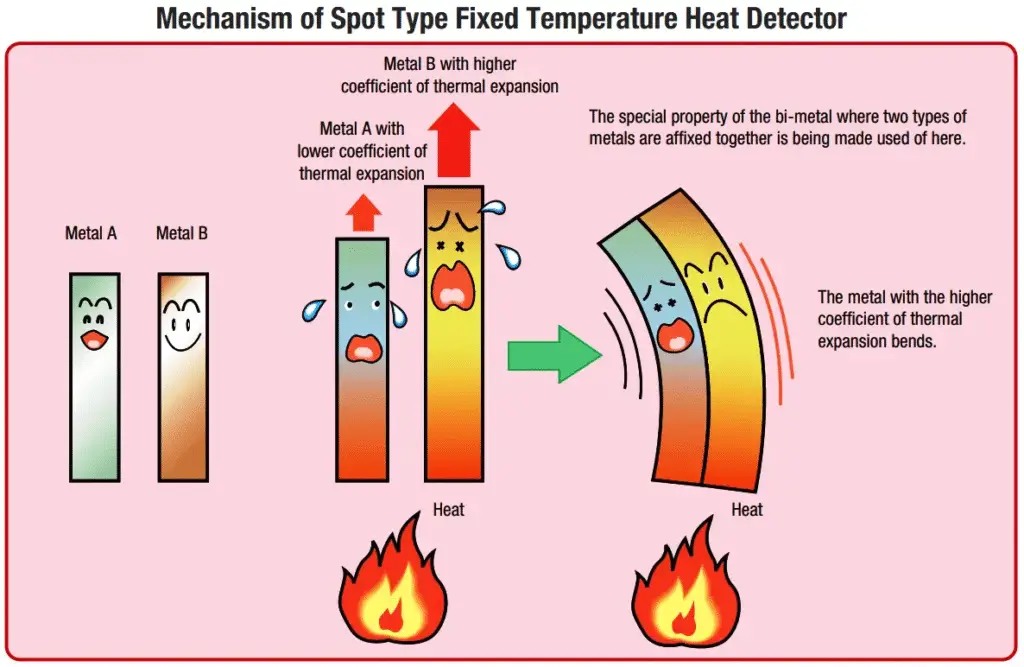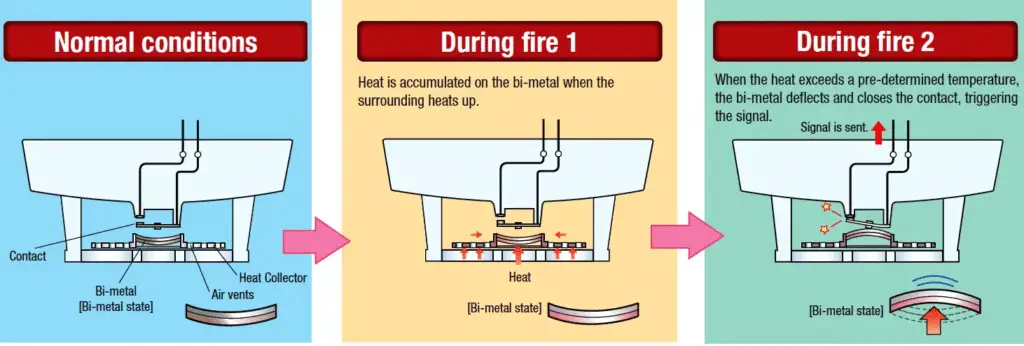Fixed temperature heat detectors are devices that are used for detecting heat in a particular area. They are usually placed in a fixed location, for example, a room.
The fixed temperature heat detectors monitor the temperature of that particular area. When the temperature of a particular area rises beyond a certain level, the heat detector activates and sends an alarm to the authorities. The fixed temperature heat detectors have a thermal sensing element.
The thermal mass and conductivity of the sensing element regulate the rate of flow of heat into the element. Heat detectors are mainly of two types based on the method of operation, which are – the rate of rise and fixed temperature. The heat detector is used to reduce the damage to property. The heat detectors are triggered when the temperature increases.

Construction of a Fixed Temperature Heat Detector
A fixed-temperature heat detector has a bimetallic switch element. This element closes on a specified temperature limit. This bimetallic switch normally is composed of two metals, and both metals have a different temperature coefficient of expansion.
Working of a Fixed Temperature Heat Detector
The bimetallic element present in the fixed temperature heat detector will heat when there is an increase in the temperature. So, the metal with a higher coefficient of expansion in the bimetallic switch will bend or curve, and result in the closure of the switch. This will indicate an alarm condition.
The line-type thermal detectors are also available in the market. These detect heat along their entire length. They have two wires which are separated by insulation. When the heat builds up beyond a certain level, the insulation melts and Thus, allowing the wires to touch each other and cause current to flow.
This will initiate an alarm. The bimetallic switch and coaxial thermal detectors are able to self-restore. But, the fusible link and melting insulation type of line thermal detectors are not able to self-restore themselves.


Image Courtesy: Hochiki
Types of Heat Detectors
Let us have a quick look into other types of heat detectors also.
Rate of Rise Heat Detectors
The rate of rise heat detector activates an alarm when the temperature increases in the surrounding area and reaches a certain level. Rate of rise heat detector is specifically used in areas where a rapid increase in temperature is most likely to indicate a fire, like in the kitchen or warehouse.
Combination Heat Detectors
Combination heat detectors are a combination of rate-of-rise and fixed temperature detectors. Combination heat detectors are designed in such a way that they are activated when either the rate of temperature increases or the temperature reaches a certain level. Combination heat detectors are suitable for temperature detection of areas that are apt to both a rapid increase in temperature and a high temperature as indications of fire.
Spot Heat Detectors
Spot heat detectors are designed for activation when the temperature within a specific area or spot will reach a certain level. Spot heat detectors are suitable for those areas where a high temperature is likely to indicate a fire, for example, an engine room or boiler room.
Advantages of Fixed Temperature Heat Detectors
- They have low cost as compared to smoke detector units.
- More reliable than the smoke detector units.
- They do not get affected by dusty or dirty environments.
- Minimal maintenance.
Disadvantages of Fixed Temperature Heat Detectors
- Slower response as compared to smoke detectors
- They can not detect the products of combustion.
- Only suitable for protecting the property
An example of the fixed temperature heat detector is Honeywell’s 2020HF thermal detectors. Honeywell’s 2020HF thermal detectors are designed to sound an alarm when the temperature reaches 78°C. Honeywell’s 2020HF thermal detectors also have a rate of rise unit for providing quick and accurate detection of fires.
Honeywell’s 2020HF thermal detectors are built by using thermal elements that are combined with application-specific integrated circuits(ASICs).

Image source: Honeywell Building Technologies
Honeywell’s 2020HF thermal detectors are conventional heat detectors. Honeywell’s 2020HF thermal detectors are small and straightforward fire detection systems.
Honeywell’s 2020HF thermal detectors have automatic drift compensation for reducing false alarms. Honeywell’s 2020HF thermal detectors have easy maintenance. Honeywell’s 2020HF thermal detectors draw low currents and have a remote alarm test feature.